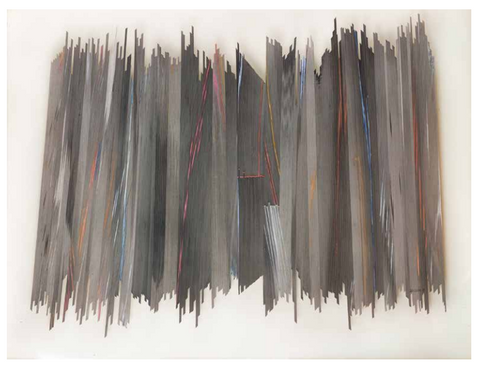Jinsook Shinde
In Jinsook Shinde's studio, a Chinese grinding stone meant for powdering natural colours sits on the ground, swaddled in silence. However, distance plays tricks with our vision. When we move closer, we realise that its lid has two dragons with interlocking heads carved on it. Interestingly, an artist's tools often provide a clue to her aesthetic choices.
In her case, the twofold meaning embedded in the image of the dragons points to the unresolved binaries of life that characterise her work. In the artist's words, she is constantly searching for "the infinite in the finite, movement in immobility, and darkness in light." This conceptual explanation of her work, when taken in conjunction with what we know of her concern with nature, may lead us to conclude that she paints abstract landscapes.
While studying art in South Korea, her mother country, Jinsook soon realized that her affinity was neither with traditional Chinese painting and calligraphy, nor with the modern western art practices. She assiduously imbibed the techniques of both traditional and contemporary art-making. She also seems to have meditated on the principle of formal repetition, which is used in traditional crafts like weaving. In her own work, she uses this principle to create an experience of rhythm, while also transforming its formal function to provide variations in tone.
Speaking of nature, the artist returns to Korea, recalling her trek through the mountains to reach the Buddhist shrines almost concealed by the verdant forest. Even as a child she was fascinated by India, the land of Buddha's birthplace. Perhaps that is why her decision to leave Korea and settle down in India with her husband, artist Vilas Shinde, did not seem like a major uprooting from her home country. Interestingly, she met Vilas in Paris while studying graphics under the famed print-maker S. W. Hayter in the early 1980s.
Indian architecture and the warm colours of the Indian landscape enchanted Jinsook. For a long time now, she has worked with the horizontal positioning of the strips in her work. Her work is inspired by the terrain of the picturesque hill station of Matheran. All the elements of nature act and react on the viewer's mind like brief Zen notations.
Jinsook's works are not simply abstract variations on a landscape. Her recent work proves, rather, that she has begun to experiment with sculptures composed from paper, light, colour, and shadow. With these works, Jinsook has moved beyond the boundaries of conventional abstraction, extending its plastic and expressive possibilities.
Her exhibit with us is a Chinese ink and dry pastel on paper made in 2020.




